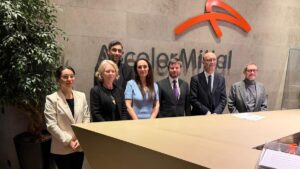
The leadership of the Ukrainian Red Cross (URC), the chairman of the board of ArcelorMittal, and representatives of the Luxembourg Red Cross discussed the issue of attracting resources for the implementation of joint humanitarian projects.
“During a working visit to Luxembourg, I met with Michel Würth, Chairman of the Board of ArcelorMittal, and representatives of the Luxembourg Red Cross at ArcelorMittal’s headquarters. We discussed opportunities for future cooperation in Ukraine and attracting resources for joint humanitarian and research initiatives,” UKK CEO Maxim Dotsenko said on Facebook on Thursday.
According to Dotsenko, for the Ukrainian Red Cross, international partnerships are about trust, shared responsibility, and real support for people affected by the war.
“It is thanks to such interactions that we can strengthen our assistance where it is most needed,” Dotsenko said.
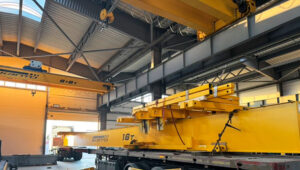
The Kryvyi Rih Mining and Metallurgical Plant PJSC ArcelorMittal Kryvyi Rih (AMKR, Dnipropetrovsk region) has purchased and commissioned a new gantry crane in the repair shop (RC) of the mining department (MD).
According to information from the company in the corporate newspaper Metallurg, the use of the new crane has made the movement of goods safer.
It is specified that the crane replacement project was implemented as part of the work to achieve FPS corporate standards for occupational safety.
Lyubov Yevseyanko, lead engineer of the GD project implementation department, noted that such cranes are manufactured individually to meet the needs of those who will use them.
“First, together with experts from the repair shop, we specified what equipment they needed. Based on this, a drawing was made, describing the parameters of the future crane. Then we worked with companies that are capable of manufacturing such a crane with high quality, in accordance with standards and within a timeframe that would satisfy us. From several options, we chose the one that best met the criteria. Work began on the manufacture of the equipment,” she said.
Igor Maly, head of the RC GD, highly praised the work of the contractors who manufactured the crane and then participated in its installation and commissioning.
“Our workshop performs repairs and manufactures metal structures, spare parts, assemblies, and mechanisms. We really needed this crane. It replaced the old one, which was no longer safe to use. There was also an urgent need for more powerful equipment: the old crane had a lifting capacity of 5 tons, but recently we have been working more often with heavier products and materials,” explained the workshop manager.
He added that the contractor, the Kyiv Lifting and Transport Equipment Plant, manufactured the crane quickly, efficiently, and in accordance with the requirements. Along with the crane, the rail track on which it moves was also replaced.
ArcelorMittal Kryvyi Rih is the largest manufacturer of rolled steel in Ukraine. It specializes in the production of long products, in particular, rebar and wire rod. The enterprise has a full production cycle, and its production capacity is designed for an annual output of over 6 million tons of steel, more than 5 million tons of rolled products, and over 5.5 million tons of pig iron.
ArcelorMittal owns Ukraine’s largest mining and metallurgical complex, ArcelorMittal Kryvyi Rih, and a number of small companies, including ArcelorMittal Beryslav.
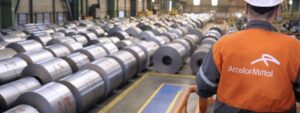
ArcelorMittal reduced its EBITDA by 4.5% in the first quarter of 2025 compared to the fourth quarter, to $1.58 billion, the company said in a statement. Compared to the same period last year, the figure fell by 19.2%.
The quarterly decline in EBITDA was due to weather conditions in Brazil, while prices and costs in Europe also had a negative impact on the figure, along with a decline in financial results in India. At the same time, EBITDA was supported by an improved situation in North America, including higher production volumes and a positive effect from price increases.
Operating profit in the last quarter amounted to $825 million, compared to $529 million in the previous period and $1.072 billion a year earlier. The figure was impacted by impairment charges of $80 million related to the closure of the South African facility, among other things.
Net profit in January-March amounted to $805 million, compared to a loss of $390 million a quarter earlier and a profit of $938 million in Q1 2024. The quarterly increase was driven by higher operating profit, foreign exchange gains (mainly due to the depreciation of the US dollar) and lower taxes.
Revenue increased by 0.6% last quarter to $14.798 billion, amounting to $14.798 billion. In the first quarter of 2024, revenue was $16.282 billion.
ArcelorMittal’s capex in January-March amounted to $1 billion. The capex target for this year is $4.5-5 billion, including $1.4-1.5 billion for strategic projects and $300-400 million for decarbonization projects.
In the first quarter, the company increased steel production by 5.7% compared to the previous three months, to 14.8 million tons (14.4 million tons a year earlier). The company shipped 13.6 million tons of steel last quarter (13.5 million tons in the previous quarter and a year earlier). Iron ore production in the quarter decreased by 6.3% to 11.8 million tonnes (10.2 million tonnes a year earlier).
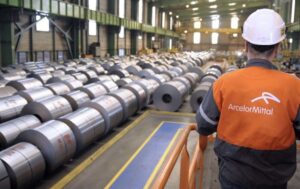
Steelmaker ArcelorMittal reduced its net loss and increased its revenue in the fourth quarter, while its EBITDA exceeded analysts’ forecasts.
According to the company’s press release, in October-December 2024, its net loss amounted to $390 million, or $0.51 per share, compared to a loss of $2.97 billion, or $3.57 per share, in the comparable period of the previous year. Excluding one-time items, earnings were $0.52 per share versus $1.18 a year earlier.
The earnings adjustment includes a one-time tax expense related to the change in the tax rate in Luxembourg ($0.4 billion) and a provision for tax litigation ($0.2 billion).
The company’s EBITDA in the fourth quarter increased by 13% to $1.65 billion from $1.45 billion a year earlier, while the consensus analysts’ forecast, presented earlier by the company itself, envisaged an increase to $1.53 billion.
ArcelorMittal’s revenue in the reporting quarter increased to $14.7 billion from $14.6 billion in the fourth quarter of 2023.
Steel production in the fourth quarter increased to 14 million tonnes from 13.7 million tonnes a year earlier, while steel supplies rose to 13.5 million tonnes against 13.3 million tonnes.
The company expects global steel consumption (excluding China) to grow by 2.5%-3.5% in 2025 compared to 2024.
Shares of ArcelorMittal are up 3.5% in trading on Thursday.
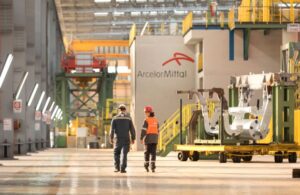
ArcelorMittal increased EBITDA by 35% in the first quarter of 2024 compared to the fourth quarter of 2023 to $1.96 billion, the company said in a statement.
The main increase in EBITDA was driven by improved performance of assets in North America, Brazil, Europe and India.
Operating profit in the last quarter amounted to $1 billion compared to a loss of $1.98 billion in the previous period.
Net profit in January-March amounted to $938 million, compared to a loss of almost $3 billion a quarter earlier.
Revenue increased by 12% last quarter compared to the fourth quarter, amounting to $16.28 billion.
ArcelorMittal’s capex in working capital amounted to $1.7 billion in January-March. The capex target for this year is $4.5-5 billion.
In the first quarter, the company increased steel production by 5% quarter-on-quarter to 14.4 million tons. Last quarter, metal shipments increased by 1.5% to 13.5 million tons. The company’s iron ore production increased by 4.8% to 6.5 million tons in the quarter.
According to ArcelorMittal’s forecasts, global steel consumption, excluding China, will increase by 3-4% in 2024. At the same time, demand in the US will increase by 1.5-3.5%, in Europe by 2-4%, in Brazil by 0.5-2.5%, and in India by 6.5-8.5%.

ArcelorMittal increased its EBITDA by 44% in Q2 2023 compared to Q1, to $2.6 bln, the company said in a statement.
The steelmaker points to improving market conditions as well as positive effects from M&A deals (the acquisition of Pecem in Brazil and the consolidation of ArcelorMittal Texas HBI). For the six months, EBITDA rose to $4.4 billion from $3.9 billion a year earlier.
Operating profit last quarter was up 62% on Q1, to $1.9 billion. January-June operating profit was $3.1 billion, compared with $8.9 in the first six months of 2022.
Net income in the April-June period was $1.86 billion (up 70%), down 63% to $2.96 billion for the first half of the year.
Revenue increased last quarter by 0.6% quarter-on-quarter to $18.6 bln. In January-June, ArcelorMittal’s revenue fell by 16% to $37.1 bln largely due to lower metal shipments and a 14.7% drop in average realized price.
ArcelorMittal’s April-June capex totaled $1.06 billion ($938 million quarter earlier), with a 2023 capex guidance of $4.5-5 billion.
In the second quarter, the company increased steel output by 1.4% quarter-on-quarter to 14.7 million tons; for the half-year, it decreased by 5.5% to 29.2 million tons.
Metal shipments fell 2% to 14.2 million tons last quarter, down 3.4% (to 28.7 million tons) in January-June.
The company’s production of yellow ore for the quarter fell 4.5% to 6.4 million tons, with 13.1 million tons produced in the six months compared to 14.2 million tons of yellow ore a year earlier.